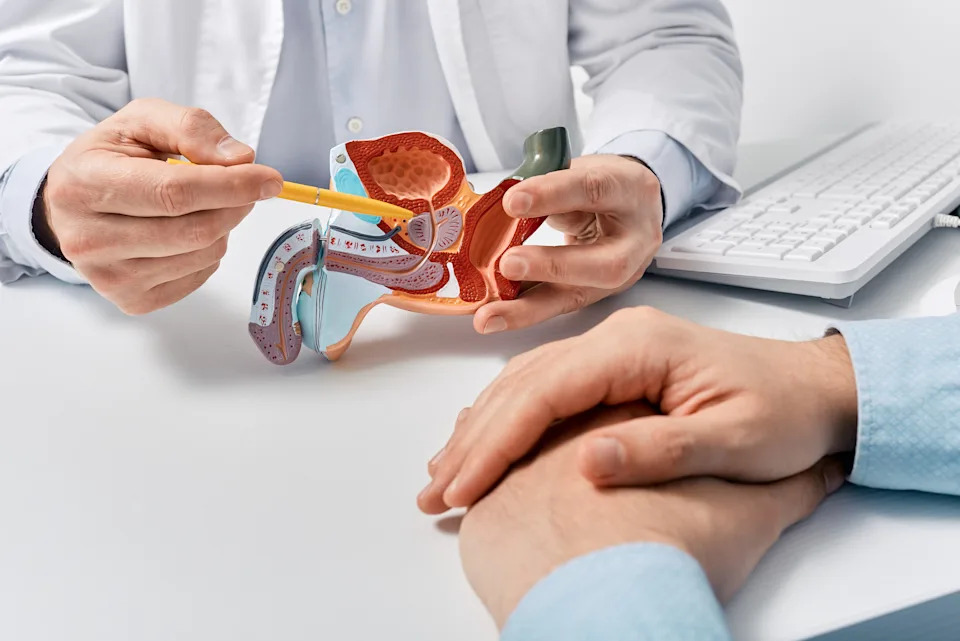This common condition affects up to three million people in the UK each year – but chances are, you’ve not heard of it.
Benign prostatic hyperplasia (BPH), otherwise referred to as an enlarged prostate (which you may have come across), impacts millions of men every year in the UK. While treatment is not always necessary, in some cases, if left untreated, it can lead to more serious health problems.
Despite how common it is, though, one in five men have no knowledge of prostate health, and even fewer know what the prostate does or the symptoms to look out for, according to new research by Nuffield Health.
Here, Mr Rahim Kaba, consultant urologist at Warwickshire Hospital, explains to Yahoo UK what BPH is, as well as the signs, symptoms and treatments available to men.
What is benign prostatic hyperplasia?
The prostate gland is located by the bladder and the rectum and helps produce semen. (Getty Images)
“As men, we often brush off changes in our health, especially when they affect something as personal as our bladder habits,” Mr Kaba says. “But the truth is, urinary problems are extremely common after the age of 50 – and in many cases, they’re caused by something both benign and highly treatable: benign prostatic hyperplasia (BPH), or prostate enlargement.”
The gland, which is part of the male reproductive system and helps create semen, is located in front of your rectum, below the bladder. Your urethra – the tube which urine is passed through – runs through the prostate.
Because of its location, an enlarged prostate can make it hard to pee, and can cause symptoms such as a urinary tract infection (UTI) or other bladder and kidney issues.
If untreated, BPH can lead to:
-
irreversible bladder or kidney damage
The signs and symptoms of BPH
Older men with an enlarged prostate may find it difficult to pass urine, or have pain when they go to the toilet. (Getty Images)
Per the expert, the most common symptoms of BPH include:
-
Getting up several times a night to pass urine
-
A weaker or intermittent flow
-
Straining or hesitancy when starting to urinate
-
Feeling the bladder isn’t completely empty
-
A sudden or urgent need to go
If you have these symptoms, book an appointment with your GP to discuss options.
You should call NHS 111, however, if you notice blood in your urine, you have pain when you pee or you cannot pee at all.
These symptoms can also be signs of prostate cancer, so it’s important to get checked out as soon as possible if they do present themselves.
“BPH is not something you have to live with, and it’s not something to be embarrassed about discussing,” Mr Kaba adds.
How to diagnose and treat benign prostatic hyperplasia
Your doctor may take a blood sample. (Getty Images)
In order to diagnose BPH, your GP or doctor may run a series of tests, including:
-
A blood test, known as a PSA
-
A urine flow check, using a machine to measure how you pee
-
An ultrasound scan to check your bladder
-
A cystoscopy (a procedure involving a camera) to look inside your bladder
When it comes to treatment for an enlarged prostate, there are a few options. These including:
Medication
There are various medications, such as tamsulosin, doxazosin and alfuzosin that are designed to encourage urination. Drugs like oxybutynin, meanwhile, are used to prevent the urge to pee so often. Then, there are medications like finasteride, which are geared towards preventing your prostate from growing. All of these are prescription-only and you will need to see your GP first.
Surgery
Some surgeries involve removing part of the prostate using lasers, steam, water jets or an electrical current. An alternative treatment is designed to widen the urethra using a small implant to help you pee more easily. Another involves small cuts to the prostate around the opening of the bladder.
Catheter
A urinary catheter is a flexible tube that’s inserted into your bladder to help drain pee when you cannot empty your bladder yourself.

They may also fit a urinary catheter to help drain pee. (Getty Images)
Other things you can do to help alleviate the symptoms include:
-
Cut down on alcohol and caffeine
-
Reduce the amount of fluid you drink before bed or going out
-
Maintain a healthy weight
-
Eat enough fibre to prevent constipation, which can add more strain on your bladder
-
Wait a few moments after peeing and try to pee again
-
Use your fingertips to press behind your scrotum to encourage the last few drops of pee out
How often should you get checked out?
A lot of men say they avoid prostate health checks through embarrassment. (Getty Images)
While the same Nuffield Health report found that a third of men believe prostate checks should start between the ages of 30-40, current guidelines recommend them from the age of 50 for asymptomatic men.
What’s more, 33% said they avoided prostate health checks because of embarrassment, 25% because of social stigma, and a further 25% through fear of diagnosis.
“The key message is simple: if you’ve noticed changes in your urinary flow, don’t ignore them. Early advice and treatment can transform comfort, confidence, and sleep,” Mr Kaba stresses. “As I often tell my patients, there’s no need to suffer in silence – effective help is available, and it’s closer than you think.”
Read more about health:
